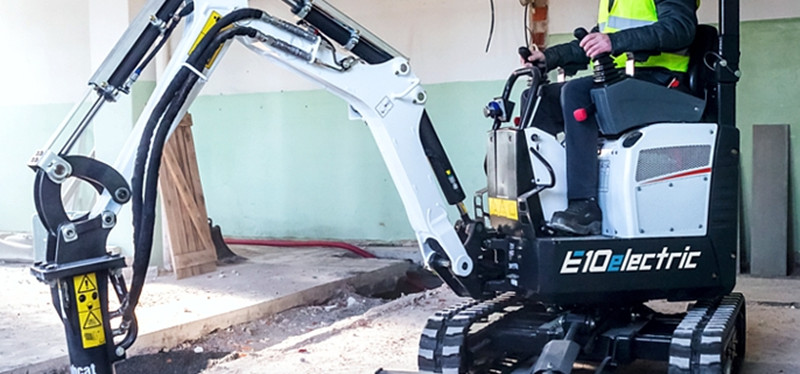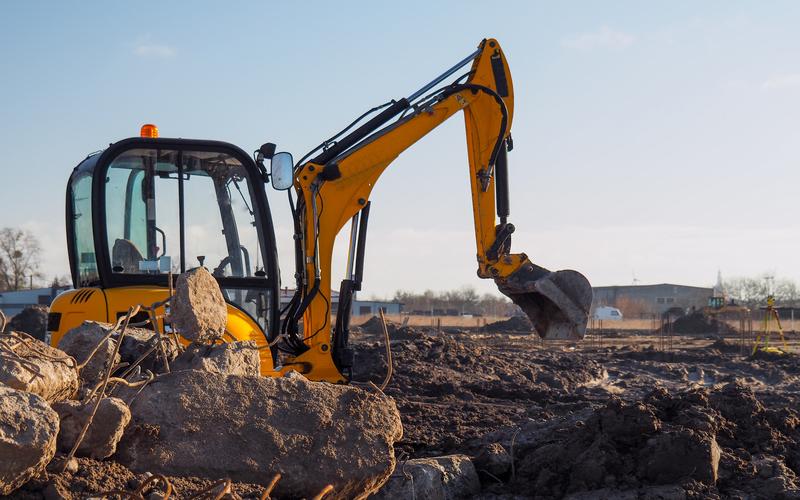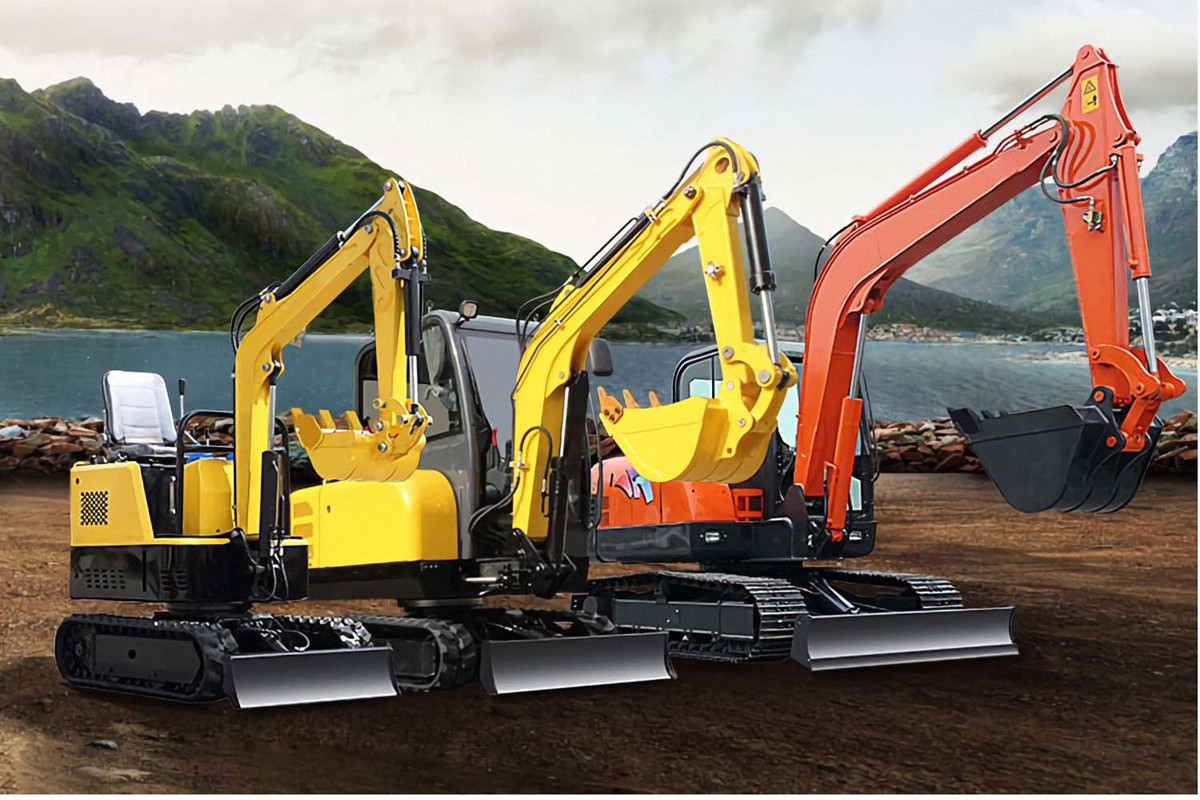The ultimate buying guide on hydraulic breaker hammer
This article is a complete guide for everything you need to know about hydraulic breaker hammers.
It will cover everything from the structure, components, and working principles to tips for purchasing, maintaining and repairing a hydraulic breaker hammer.
We will also include a FAQ and troubleshooting guide that covers every detail you need to know.
The Auther work with teams with over 20 years of industrial experience and would like to share the knowledge with people in the field for free.
It helps both beginners and professionals to have a better understanding of hydraulic breaker hammers.
Among the key subjects, the “Ultimate Buying Guide of Hydraulic Hammers” includes six chapters.
Definition of hydraulic breaker hammer. A brief introduction of its history and an overview of types and applications.
Hydraulic breaker structure. This section covers major components and provides a general sketch of the structure.
Hydraulic breaker working principles. An informative chapter with charts and videos to explain the technical principles of operating a hydraulic hammer.
How to select hydraulic hammers. Six most practical tips are offered for choosing the right hammer; this section is intended to offer general suggestions in the form of a buying guide.
Hydraulic hammer maintenance guide. Most common maintenance suggestions and video guidance. A complete pdf maintenance guide is for download.
The FAQ about hydraulic breakers. A list of FAQs about daily use, repairing, maintenance, and troubleshooting—all the details you need to know!
Share this article on your SNS if it does help!
What is a hydraulic breaker hammer?
The ciocan de spargere hidraulic is a type of heavy construction machinery that is mounted on excavators, backhoes, skid steers, mini-excavators, and stationary plants.
Acționat de puterea hidraulică, sparge rocile în dimensiuni mai mici sau demolează structurile de beton în bucăți ușor de gestionat.
They are so versatile tools that can handle a wide range of jobs, with different sizes and models to suit particular needs.
A good hammer is built to last, commonly used in various applications like demolition, construction, road building, mining and quarrying, tunneling, and landscaping.


Hydraulic Breaker hammer Structure
In order to understand how a hydraulic breaker hammer works, or what hydraulic hammer working principle is, the structure and major components need to be clarified first.
Un ciocan de spart hidraulic este format din trei părți majore: capul din spate (camera de azot), ansamblu cilindru, și capul din față.
Vom veni la ele separat.

1. Capul din spate (Nitrogen Cciocan)
Capul din spate este o cameră pentru stocarea azotului.
Când este plasată la presiune ridicată, această cameră umplută cu azot acționează ca un amortizor la cursa pistonului de retur.
De asemenea, funcționează ca un amplificator de impact atunci când pistonul se deplasează în jos.
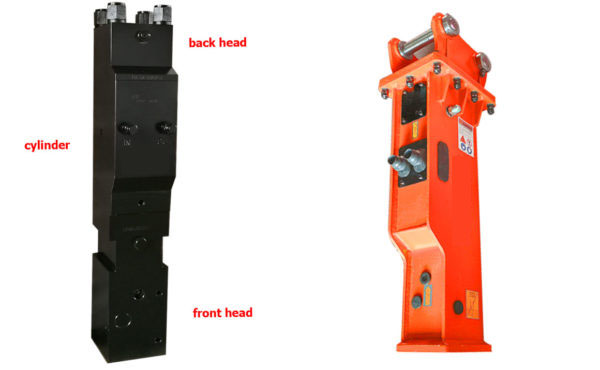
2. Ansamblu cilindru
Ansamblul cilindrului este partea centrală a unui ciocan hidraulic.
Este format în principal dintr-un cilindru, un piston și o supapă de control.
Pistonul și supapa sunt singurele două părți mobile ale unui ciocan hidraulic.
Pistonul se mișcă în sus și în jos și lovește unealta, în timp ce supapa se rotește pentru a controla direcția fluxului de ulei.
Este locul unde are loc mișcarea și unde este generată puterea hidraulică.
Cu controlul supapei principale uleiul, cel fluxul hidraulic conduce mișcarea pistonului pentru a genera energie de impact.
Un set de kituri de etanșare sunt introduse în interiorul cilindrului pentru a preveni scurgerile de ulei.
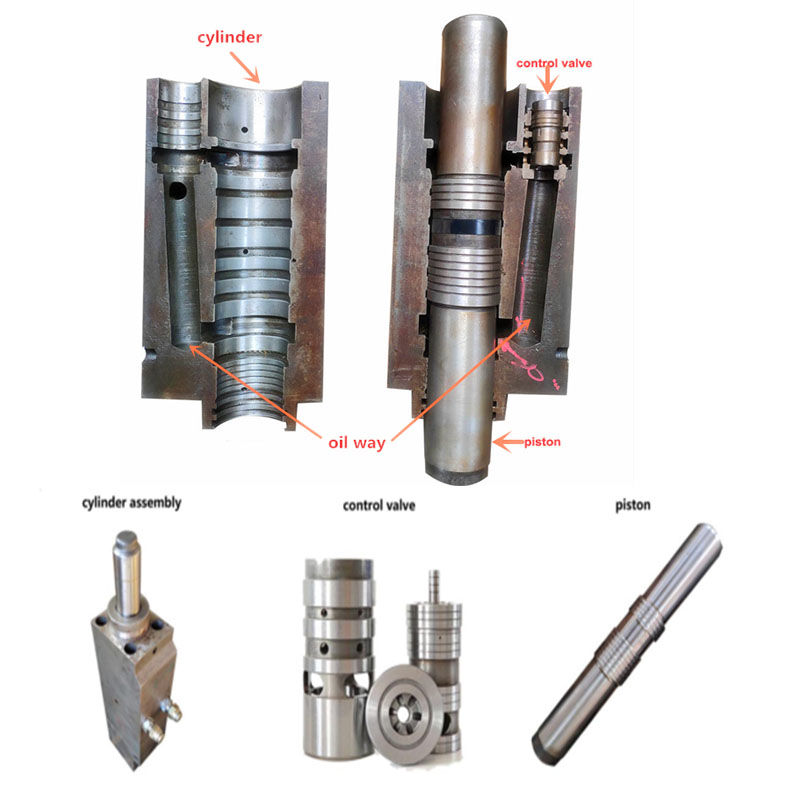
3. Capul din față
Aici pistonul se conectează cu dalta (sau unealta de lucru).
Dalta este fixată cu bucșe și știfturi, care sunt piesele care trebuie înlocuite cel mai frecvent.
Capul frontal atinge direct suprafața de lucru, iar o carcasă de tip cutie l-ar putea proteja de uzură și poate duce la o durată de viață mai lungă.
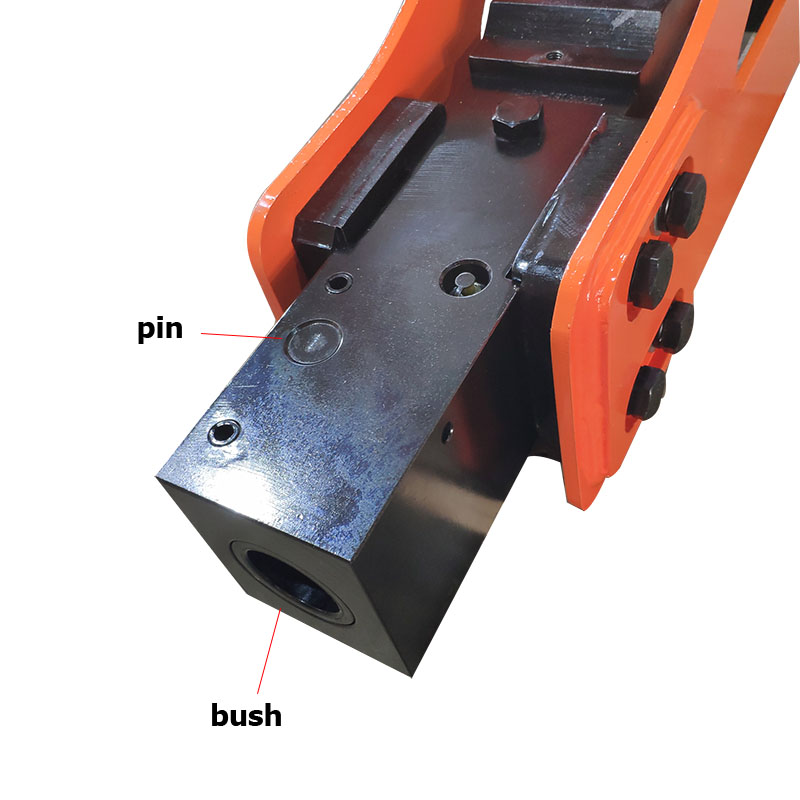
Besides the 3 major components, a hammer also consists of dozens of accessories.
Principiul de funcționare al ciocanului spargetor hidraulic
Now comes the killer part.
This chapter contains a lot of great technical information.
Dacă aveți experiență în inginerie, această secțiune vă va ajuta să înțelegeți aspectele tehnice ale modului în care funcționează și funcționează un ciocan hidraulic.
Dacă credeți că aceste diagrame sunt plictisitoare și greu de înțeles, puteți trece direct la concluzie.
As stated in the last chapter, with the main valve controlling the flow of oil in and out, the hydraulic flow drives piston moves up and down, and generate impact energy.
In this chapter, four flow charts are going to be used to clarify the whole process.
Remarci
- 1-8 înseamnă camere de curgere a uleiului
- Zonele roșii sunt pline de flux de ulei de înaltă presiune
- Zonele albastre sunt pline de flux de ulei de joasă presiune
- Camerele 3, 7 au întotdeauna presiune scăzută, deoarece se conectează la „ieșire”
- Camerele 1, 8 au întotdeauna presiune mare, deoarece se conectează la „înăuntru”
- Presiunea din camerele 2, 4, 6 se modifică odată cu mișcarea pistonului
- Uleiul de înaltă presiune intră și umple camerele 1 și 8, acționând asupra părții de capăt a pistonului și împingându-l în sus.
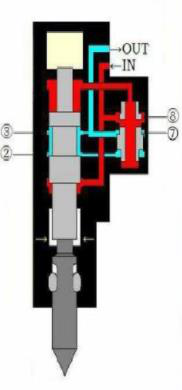
2. Când pistonul se mișcă în sus spre limita sa, camerele 1 și 2 se conectează și uleiul curge din camera 2 la 6.
Supapa de control se mișcă în sus din cauza diferenței de presiune (presiunea uleiului în camera 6 este mai mare decât în 8).
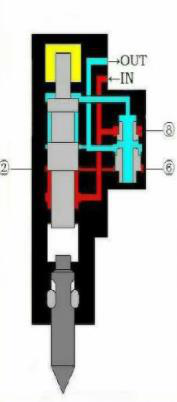
3. Când supapa de control atinge limita superioară, orificiul de intrare se conectează la fluxul de ulei din camera 8, ceea ce face ca uleiul să curgă în camera 4.
Datorită presiunii ridicate a uleiului din camera 4, împreună cu azotul de rezervă, pistonul se deplasează în jos.
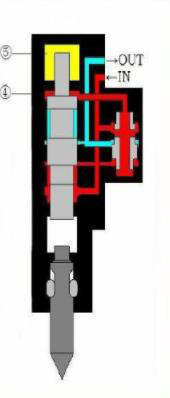
4. Când pistonul coboară și lovește dalta, camerele 3 și 2 se conectează și ambele se conectează la camera 6.
Din cauza presiunii ridicate a uleiului din camera 8, supapa de control se deplasează în jos și orificiul de intrare se conectează din nou la camera 7.
Apoi începe o nouă circulație.

Concluzie
O singură propoziție este suficientă pentru a rezuma principiul de funcționare a ciocanului hidraulic: “Schimbarea relativă a poziției pistonului și supapei, care este condusă de fluxul de ulei care merge „înăuntru” și „în afara”, transformă puterea hidraulică în energie de impact.”
Watch the short video for a thorough explanation.
How to choose a hydraulic breaker hammer?
Now you know what the hydraulic breaker is, and you intend to buy one.
A hydraulic breaker is not a small investment, nor is it built for an easy life.
Selecting the right hammer could save a lot of money in the long run and boost your efficiency.
We summarize six most practical tips to explain “how to choose a proper hydraulic breaker hammer”.
1. Size
A hydraulic breaker hammer must mount with the right size carrier. The proper match can optimize efficiency while protecting your valuable investment.
Since there is no universal industrial standard, the size of the breaker can be measured by weight ratio, impact energy level, chisel/piston diameter, etc.
Each has its own merits, and I take piston/chisel diameter most into consideration.
In short, bigger tools & chisels normally lead to a higher power and lower frequency. The breakers are mounted with heavier carriers.
For instance, a hammer with 140mm tool diameter is a good match to a 20-ton class, like Cat 320c, Komatsu pc200 excavator.
And a 45mm chisel diameter breaker is a good fit to your 2-ton Bobcat skid steer or a 1.8 ton Kubota miniexcavator.
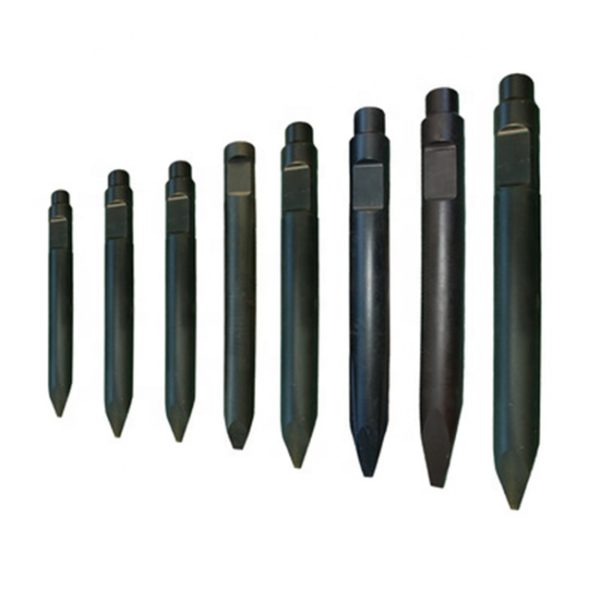
2. Project & application
The hydraulic hammer is versatile enough to work in various applications, so it is critical to match your machines with the intended project.
In mining or quarrying, impact power counts most, which may require a larger hammer with a slower rate in order to break up rocks or limestone into small pieces.
When it comes to road demolition or tunneling, penetrating power and impact rate is the key factor to improve efficiency. A medium size hammer for 10-ton class is a good option.
For post hole digging or landscaping, a skid steer or mini excavator mounted with a 1-ton class breaker works best.
It is your choice to use a 30-ton class heavy duty hammer on road demolition, but it is a waste in my opinion.
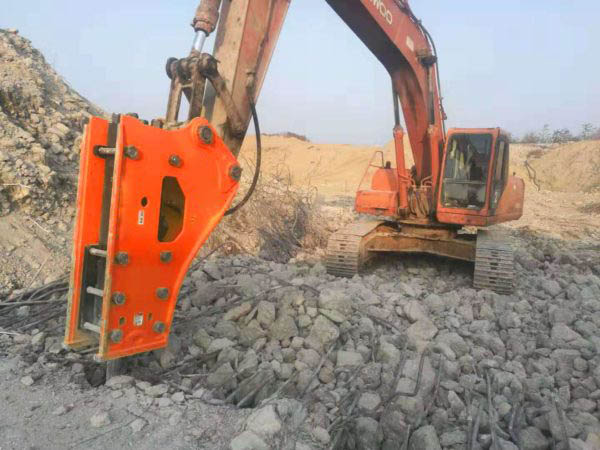
3. Proper hydraulic flow
Hydraulic breakers are driven and powered by the hydraulic flow of excavators. Some can adapt to a wide range of flow, while some can not.
Overflow will damage the hammer due to the extra pressure. While without sufficient flow, the hammer will become slow, weak, and unproductive.
In principle, the wider range means better universality while narrow-flow breakers bring more productivity.
For instance, the Cat 130H hydraulic breaker hammer (129.5mm tool diameter, 18-36 ton excavator class) adapts to the flow range 120-220 l/min.
And its best match fluctuates around 20-ton class; this is best suited to road building and construction.
No doubt it could work under higher oil flow and heavier duty carriers (which means more comprehensive applications, like mining and quarrying),
It might not be a perfect option.
A new hammer with a bigger piston and tool diameter might work better in this case.
For instance, a heavier hydraulic hammer of 155mm diameter chisel and piston is more powerful and productive on a quarry plant.
So do you select one hammer for better universality or several for the best flow match? That’s your call.
4. Type of housing
There are three types of shells or housings for a rock breaker, and each has its own features.
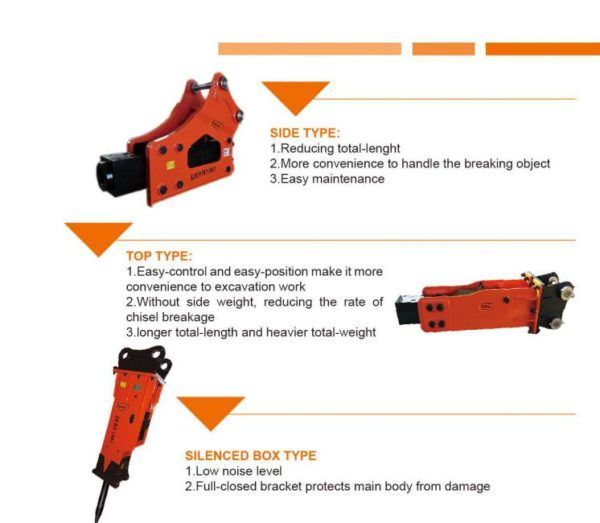
Choose a box type, or silenced type, to make the most use of it, not just for keeping noise level down.
The full closed housing made of thickened wear-resistant steel plates will protect the main body and front head from wearing and impacting.
Rock breakers do not have an easy life, and better protection will extend service life, which in turn protects your investment.
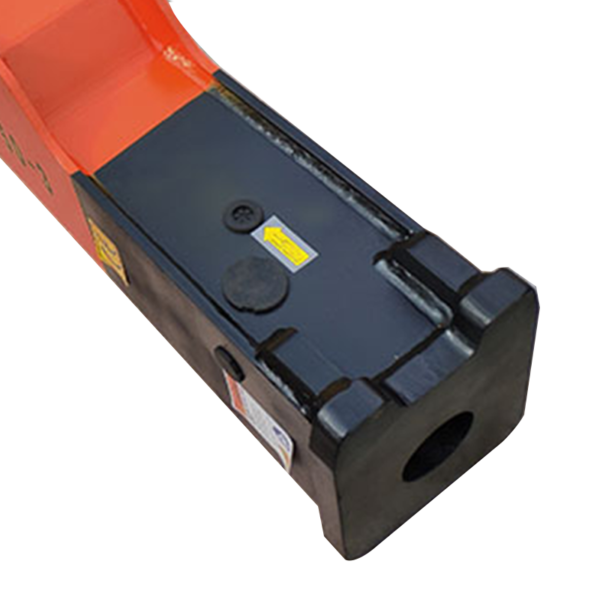
box type wear-resistance housing
5. Maintenance cost
When choosing a hydraulic breaker, maintenance cost is a long-term expense to take into account.
Hydraulic breaker maintenance costs money, and it deserves every dollar you invest in it.
It happens when parts are worn out and need to be replaced regularly.
Ask your dealer or service center for the retail price of pins, bushes, chisels and seals kits, as well as the time interval for replacement.
Then estimate a budget you would like to pay for it.
Regular and proper maintenance to your hydraulic breaker guarantees working efficiency and long service life.

6. Used & rebuilt hydraulic hammer
A hydraulic hammer is not a toy and usually work under tough circumstances.
Occasionally it requires rebuilt.
It is true that a hammer could be rebuilt, also a good way to make it work longer.
But it might be an issue when it comes to purchasing a used or rebuilt one.
You never know if the piston is damaged or if the cylinder is scratched just by looking at it.
It might occur that the seal kits damage after one week, or oil leakage because the cylinder gets rust.
Buying an unqualified rebuilt hydraulic breaker hammer may seem cheap first, but it may cost thousands of dollars after months of use.
Make sure you are buying a used or rebuilt hydraulic hammer from a trustworthy rebuilt center.
Or just buy a new one.
Hydraulic hammer maintenance guide
Proper maintenance and regular parts replacement can lead your hydraulic hammer to better performance.
And a key factor to make its long service life.
To get an overview of it, we sum up the most common maintenance suggestions to clear your daily confusion.
Greasing
Proper lubrication is critical to extending the life of your rock breaker.
We recommend greasing your hammer every two hours of use.
Failure to grease regularly will significantly increase wear rates and reduce the lifespan of your tool, bushings, and front head components.
Storage
A hydraulic breaker hammer can be stored either vertically or horizontally. For long term storage, keep it standing up would be a better option.
This will allow the breaker’s weight to push the tool and piston up inside the breaker.
If you leave them on their sides for a long time, all the seals have to support heavy internal pieces like the piston.
O-rings and backing rings aren’t meant to be load bearing.
Nitrogen check & Nitrogen charging
Click the link below for a step-by-step video guide.
FAQ & Troubleshooting Guide
1. What factors affect a hydraulic hammer’s power?
The power of the hydraulic hammer is affected mainly by three factors: nitrogen pressure (back head pressure), hydraulic flow, and impact rate.
The amount of nitrogen is very specific; overcharging the nitrogen will make it stop hammering, while low nitrogen pressure results in weak hammering.
Hydraulic flow directly affects working pressure. Over-flow can damage the hammer very quickly, so be sure to work within the proper hydraulic range.
There is a frequency valve on the cylinder body responsible for the impact rate. Adjust it manually according to working conditions.
Basically, under certain working conditions, a slower impact rate leads to a more powerful impact, and higher frequency means a lighter blow.
2. How often does the seal kit need to be replaced?
It depends on working conditions, makes, and age. We recommend every three months.
3. Can a broken piston be repaired?
No, a broken hydraulic hammer piston can never be fixed or chrome plated. Close tolerances and impact energy make it impossible. It could damage your cylinder and cost thousands of dollars in the long run.
4. What are the common reasons for piston damage?
Contaminated oil, over-worn inner bushings, and lack of greasing could lead to piston damage. Keep in mind a piston cannot be repaired, so be sure to change out your damaged piston right away.
5. Can the hydraulic breaker cylinder be repaired?
Yes, normal scratches can be fixed and polished, but only once! This is because the carburized layer thickness is about 1.5-1.7mm after heat treatment, so after polishing it still has around 1mm, and the surface hardness is still guaranteed. This repair is only possible for the first time.
6. Why does the hydraulic hammer suddenly stop hammering?
- Backhead pressure is too high. Release nitrogen and recharge as specified.
- The backhead is filled with oil. Disassemble the back head and replace the seal.
- The control valve stuck. Disassemble and clean the valve, replace the worn valve.
- Oil flow is not sufficient. Repair pump, adjust the hammer valve.
7. Why is impact so weak?
- Back pressure is too low. Check back pressure and recharge as needed.
- Oil is contaminated. Change hydraulic oil and filters.
- Operating pressure is low. Check the pump and pressure relief valve.
- Return line back pressure is too high. Check filter and hose connections.
- The working tool is not fully engaged. Use correct down pressure. Be sure the steel and front cover is not worn and have been properly greased.
8. Why is the hydraulic hammer not working after installation?
- Improper bushing replacement. Refit the inner bushing. Make sure to use the original.
- Quick couplers are installed wrong. Check connectors and replace as needed.
- Supply hoses have been reversed. The pressure line from the pump must be connected to port marked IN. The return line connects to port marked OUT.
- Nitrogen pressure is too high. Release nitrogen and recharge as needed.
- The stop valve is closed. Open the stop valve.
9. Why is blank firing prohibited for hydraulic hammers?
When the tool is not in contact with the working surface, hammering the piston is called “blank firing”.
This causes serious damage to the hydraulic hammer body. Pins and bolts may crack, and the front head might break due to the extreme impacting energy.


